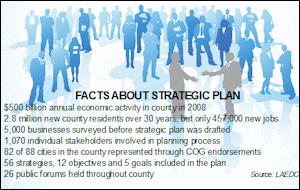At least two more community stakeholders have recently backed the Los Angeles County Economic Development Corporation’s countywide strategic plan designed to boost economic development in the region. The San Fernando Valley Council of Governments voted to endorse the plan on Aug. 12, and the Santa Clarita City Council made a similar vote on Sept. 14. The endorsements came just as the LAEDC is driving its implementation period, during which it is looking to its large group of backers to start taking action on the Los Angeles Strategic Plan for Economic Development within their own communities. “It really has moved from being just a plan to a grassroots movement to affect transformational change in our communities,” said David Flaks, the LAEDC’s senior vice president of strategic initiatives. The Los Angeles County Board of Supervisors endorsed the plan on Dec. 22, and the city of Los Angeles followed with its own endorsement on July 15. The plan has also received endorsements from the cities of Palmdale and Lancaster, as well as from various organizations and individuals. Five councils of government, representing 82 of 88 cities within Los Angeles County, have approved the strategy as well. Some groups have already started taking the necessary steps to move forward with the economic development roadmap, which focuses on preparing an educated workforce, creating a business-friendly environment, enhancing quality of life, implementing smart land use and building 21st Century infrastructure. The strategic plan, which includes five goals, 12 objectives and 56 strategies for economic development, was created in response to the region’s underperformance in job creation in recent decades, even in the face of rapid population growth, Flaks said. Drafting objectives While more recent endorsers have not had much time to get started on their implementation efforts, other stakeholder communities are holding meetings, creating studies and drafting new economic development objectives. As a result of the countywide goal to implement smart land use, Lancaster city officials are looking into opening another business park within the city and are currently negotiating on some properties, said Luis Garibay, the city’s senior redevelopment projects coordinator. “Putting in the necessary infrastructure to attract some of these firms – we’re being more aggressive in doing that because we understand that when businesses want to move, they don’t want to wait a year or two years to get their businesses up and going,” Garibay said. The two objectives of the smart land use goal are for communities to maintain an adequate supply of jobs-creating land, and also to develop and rehabilitate land to meet strategic economic development objectives. The County of Los Angeles is currently in the process of collecting data and recommendations from its various departments to determine what the county is already doing to fall in line with the LAEDC’s proposal, what else it could do with its current resources and what it could do with additional resources. Each strategy within the plan’s five components was matched with a county department of relevance this spring. Collection of recommendations from each department is expected to be completed within the next few weeks, said Martin Zimmerman, the assistant chief executive officer for the county’s Office of Strategic Initiatives. After that, review meetings will likely be held with the LAEDC, Zimmerman said. “We’d like to work with them in analyzing the results and have a discussion where reasonable linkages are possible,” he said, referring possible collaborations with other stakeholders in the county, a major goal behind the LAEDC’s overall initiative. Implementation plan Los Angeles Councilman Richard Alarcón, who is also chairman of the Jobs and Business Development Committee, said the city is also undergoing an evaluation process. An implementation and tracking plan is expected to be presented to the committee on Dec. 14. However, the jobs committee has already worked to introduce various business-friendly motions that reflect goals within the strategic plan, he said. Some of those include a motion for a business tax holiday, a motion proposing to increase the tax cap for production companies and a motion to lower fees and taxes for restaurants. Alarcón said he expects immediate action to follow the implementation feedback. “I anticipate many more reforms that are consistent with the strategic plan,” he said. While the LAEDC drafted the strategic plan for economic development and is helping manage its implementation, the group’s leaders say the plan is not its own but belongs to the region as a whole. The group had the input of more than 1,000 stakeholders throughout the county at 26 public forums. About 5,000 businesses were also surveyed to identify the region’s economic needs. The organization has established groups to serve as “implementation champions” to help jumpstart action within each of the plan’s five goals. It has even set up a blog to highlight the accomplishments of local cities and groups that fall in line with the stated goals. “The community needs to take responsibility for what goes on where we live and work,” Flaks said. Santa Clarita Councilwoman Laurie Ender, who brought the strategic plan to her council after she voted on it as a member of the San Fernando Valley Council of Governments, said follow-through by stakeholders is important. “You can’t find this and hang it on the wall,” she said. “This has got to be an action plan.”
